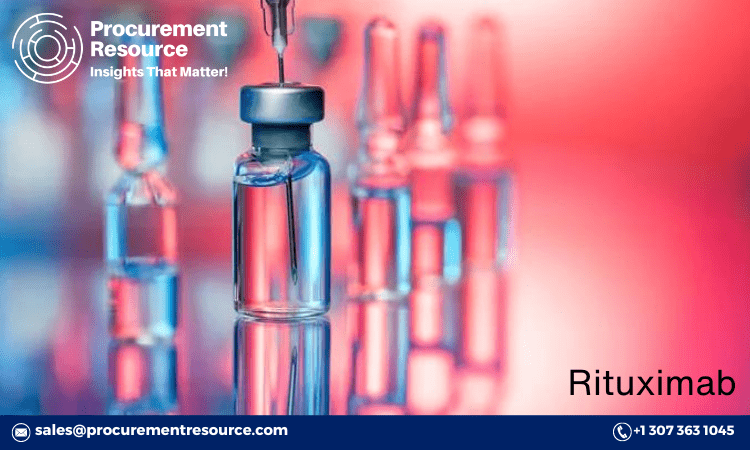Rituximab, a monoclonal antibody used to treat various autoimmune diseases and certain types of cancer, has revolutionized medical treatments in these fields. Understanding the production cost of rituximab is crucial for manufacturers, healthcare providers, and policymakers. This report delves into the various aspects that contribute to the overall production cost of Rituximab, providing a comprehensive analysis of the production process, manufacturing report, raw material costs, and the latest news in the industry.
Production Process
The production process of rituximab is intricate and highly specialized, involving several critical steps to ensure the quality and efficacy of the final product. The process can be broadly divided into the following stages:
Request For Sample: https://www.procurementresource.com/production-cost-report-store/rituximab/request-sample
Cell Line Development
The production of Rituximab begins with the development of a cell line that can produce the monoclonal antibody. This involves genetic engineering to insert the gene coding for Rituximab into a host cell, commonly Chinese Hamster Ovary (CHO) cells. These cells are then selected and cultured to create a stable cell line capable of producing high yields of Rituximab.
Upstream Processing
Once the cell line is developed, upstream processing begins, which involves the large-scale cultivation of the cells in bioreactors. The cells are grown in a nutrient-rich medium, and their environment is carefully controlled to optimize growth and antibody production. This stage can last several weeks and requires constant monitoring and adjustment of parameters such as temperature, pH, and oxygen levels.
Harvesting and Purification
After the cells have produced sufficient quantities of Rituximab, the next step is harvesting and purification. The cells are separated from the culture medium, and the Rituximab is extracted. The purification process involves several chromatography steps to remove impurities and ensure the antibody’s purity and potency. This stage is critical as it directly impacts the quality and safety of the final product.
Formulation and Fill-Finish
The purified Rituximab is then formulated with excipients to stabilize the antibody and prepare it for administration. This formulated product is filled into vials or syringes and subjected to rigorous quality control tests to ensure consistency and safety. The fill-finish process must adhere to stringent regulatory standards to maintain the product’s integrity.
Manufacturing Report and Process
The manufacturing report provides a detailed account of the entire production process, including the scale of production, equipment used, and the operational efficiency. Key aspects covered in the report include:
Scale of Production
Rituximab production can be conducted on various scales, from pilot-scale to commercial-scale manufacturing. The scale of production significantly influences the cost, with larger batches typically reducing the per-unit cost due to economies of scale. However, scaling up also introduces challenges such as maintaining consistency and managing increased risks of contamination.
Equipment and Facilities
The production of Rituximab requires specialized equipment and facilities, including bioreactors, chromatography systems, and aseptic filling lines. Investment in high-quality equipment and facilities is essential to ensure efficient production and compliance with regulatory standards. Regular maintenance and upgrades are necessary to sustain production efficiency and product quality.
Operational Efficiency
Operational efficiency is a critical factor in managing production costs. This includes optimizing process parameters, reducing downtime, and implementing quality control measures to minimize batch failures. Continuous process improvement and the adoption of advanced manufacturing technologies can significantly enhance operational efficiency and reduce costs.
Raw Material Costs
The raw material costs form a substantial part of the overall production cost of Rituximab. Key raw materials include:
Cell Culture Media
The nutrient-rich media used to culture the cells is a significant cost component. High-quality media are essential to support cell growth and antibody production, and any variation in media composition can impact the yield and quality of Rituximab.
Purification Resins
Chromatography resins used in the purification process are another major expense. These resins must be of high quality to effectively remove impurities and ensure the purity of the final product. The cost of resins can vary based on their type and the scale of production.
Excipients and Formulation Ingredients
Excipients used in the formulation process, such as stabilizers and preservatives, contribute to the production cost. The selection of these ingredients must balance cost with the need to maintain the stability and efficacy of Rituximab.
Packaging Materials
Packaging materials, including vials, syringes, and labels, also add to the production cost. These materials must meet regulatory standards to ensure the product’s safety and integrity during storage and transportation.
Latest News
Staying updated with the latest news in the Rituximab production industry is essential for understanding market trends, regulatory changes, and technological advancements. Recent developments include:
Regulatory Updates
Regulatory agencies worldwide, such as the FDA and EMA, continually update guidelines and standards for the production of biologics like Rituximab. Manufacturers must stay informed about these changes to ensure compliance and avoid production delays or penalties.
Technological Advancements
Advancements in bioprocessing technologies, such as single-use bioreactors and continuous manufacturing, are transforming the production landscape. These technologies offer the potential to reduce costs, increase efficiency, and enhance product quality. Companies investing in these innovations can gain a competitive edge in the market.
Market Dynamics
The demand for Rituximab continues to grow, driven by its expanding therapeutic applications and the increasing prevalence of autoimmune diseases and cancers. Market dynamics, including competition, pricing strategies, and supply chain challenges, play a crucial role in shaping production costs.
Industry Collaborations
Collaborations between pharmaceutical companies, research institutions, and technology providers are fostering innovation and driving improvements in Rituximab production. These partnerships can lead to the development of new production methods, cost-saving strategies, and enhanced product offerings.
Conclusion
The production cost of Rituximab is influenced by a multitude of factors, including the complexity of the production process, the scale of manufacturing, raw material costs, and the latest industry developments. By understanding these elements, stakeholders can make informed decisions to optimize production, manage costs, and ensure the availability of high-quality Rituximab for patients worldwide. Keeping abreast of regulatory updates, technological advancements, and market dynamics will be key to maintaining a competitive edge in this evolving landscape.
